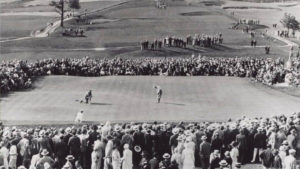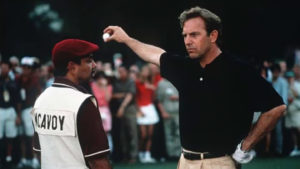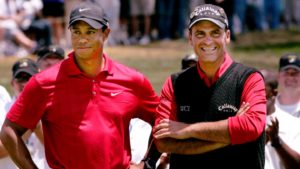
TIN CUP, BETTING TIPS AND TALKING LIKE FALDO…YOUR GUIDE TO THE 2025 GOLF U.S. OPEN
Why do they make it so hard, how did Rocco and Tiger change US Open history and why finding dancefloors are good but carding snowmans are bad…your 5–minute guide to the U.S. Open.
The hardest challenge in world golf?
You’re watching the world’s best golfers on TV on a Sunday afternoon from the comfort of your living room.
They effortlessly parachute golf balls from 80 metres out to within a few centimetres of the hole. They drive balls as straight as an arrow over 200+ metres and then sink putts from 30 metres out on lightning fast, undulating greens under the utmost pressure.
It all looks pretty easy, right? Spoiler alert: it’s not.
Now picture this. The Professional Golfers’ Association of America (USPGA) then decide that when they organise the US Open every year, they’re going to make it an even harder challenge than usual.
Preferably harder than any golf course in the whole world for that one week in June. So they start by picking one of the hardest championship golf courses in the whole of the United States for it to be played at. And next, they then do their best to make it even harder to play, using a combination of manipulation of the course in terms of its design, and other tricks, including:
- Lengthening the course for the week so each hole is longer (and harder) to reach.
- ‘Pinching’ (there’s your first proper golfing term for the day) the fairways, so the fairway is narrower than usual and surrounded by hazards such as bunkers, trees and other obstacles. Meaning that if you miss the fairway, you’re likely to be in trouble. Bethpage Black in New York, which hosted the US Open in 2002 and 2009, is famous for its pinched fairways.
- The most likely outcome if you miss the fairway off the tee is for the ball to end up in the rough. But not just any rough that’s a couple of centimetres in height. The rough is left deliberately high (known as ‘primary rough’ or ‘open rough’) requiring the world’s best to use all their strength, experience and skill to get it out of there and into a safe position.
- If the knee-high rough doesn’t get you, the greens probably will. They’re deliberately undulating, meaning it’s a minor miracle if you ever get the chance to actually putt in a straight line from more than three metres out. It’s not unusual for golfers to be aiming five metres left or right of the hole just to get it anywhere near the cup (hole). When Pinehurst was used for the US Open in 2005 and the greens were particularly treacherous, former player and commentator Jonny Miller said it was ‘like trying to hit a ball on top of a VW Beetle’.
It all helps to explain why these conniving (sadistic?) minds at the USPGA have produced courses where, in seven of the last 24 editions, par or worse has still been enough to win it.
In 2006, Australian Geoff Ogilvy won with +5 and the following year Argentinean Angel Cabrera won it with the exact score; scores that wouldn’t get you into the Top 30 at most of the other Majors.

The nuts and bolts of a tournament that’s 130 years old
- The first-ever edition of the tournament was in 1895 at Newport Country Club and was played in a rather unusual format by today’s standards: four rounds of nine holes, played over a single day.Englishman Horace Rawlins, just 21, won it and received 150 bucks in cash and a gold medal worth another 50. If you accept his prize was worth 200 dollars in total, that would equate to between 6000 and 9000 USD in today’s money, based on different calculation methods.It’s a far cry from the 4.3 million USD cheque pocketed by Bryson deChambeau when he won it last year, part of the 21.5 million USD total prize fund. The winner’s cheque and total prize pool has gone up every single year since 1981, first reaching the 1 million USD mark for the victor in 2002, when it was won by a certain … Tiger Woods. It’s the largest prize purse of the four Majors.
- It’s one of three Majors played on US soil, the third of the four Majors to be played chronologically and takes place in June, in an attempt to avoid bad weather and delays to the schedule. Like the USPGA Championship and The Open, and unlike the US Masters (which is always played at Augusta, Georgia), it’s played on a different course every year. That said, the course has to tick numerous boxes to even be considered as a US Open venue. Two of which are, as we know, that it’s a very long course and an extremely difficult one.
- The field is made up of 156 players at the start on Thursday, and as is the case with all pro golf tournaments, half of the field will be eliminated by the end of the second round on Friday afternoon, known as ‘the cut’.
- There are numerous different ways players can qualify for the US Open including: via their current world ranking, having won it in any of the previous 10 years, having won one of the other three Majors over the previous five years, having won one of a handful of selected tournaments played that season and having finished in the Top 10 in the tournament the previous year. There are also various ways that Amateurs can qualify for it.

Tin Cup – When Kevin Costner refused to lay up on the 18th
Golf has been featured in quite a few films. From the cheap jokes and dirty on-course tricks of ‘Caddyshack’ to the unlikeliest of professional golfers that was ‘Happy Gilmore’ to the half-mystical/half-truthful inspirational story of the ‘Legend of Bagger Vance’, fairways and film have often gone hand in hand with some success over the years.
But perhaps the best, or at least most realistic depiction of professional golf on film comes in the form of ‘Tin Cup’. Kevin Costner (whose nickname is Tin Cup) plays a washed-up former pro who gives golf lessons in his backyard for beer money. One of his clients includes the uber-cool and immaculately dressed Rene Russo, to whom he delivers the wonderful line: “Such a beautiful woman, such an ugly swing”.
Russo convinces Tin Cup to get back to doing what he does best and have one final shot at winning a major event that he’s come so close to doing so often in the past. But here’s where things get interesting.
The event that he comes out of retirement to play is none other than the US Open! Not only does it offer an interesting and accurate insight into what a player not in possession of a PGA tour card has to do to qualify for the US Open, but as Costner himself points out in the film: “This is the tournament us golfers all really want to win”.
We won’t spoil it for you if you’ve never seen it, but if he’d had his time again, maybe Tin Cup should have laid up on the 18th, rather than going for the pin. And that’s all we’re saying.

The Playoff rule: When Rocco and Tiger played for five days
Back in 2008, a hobbling Tiger Woods sporting a bad knee injury just, just about holed a tough putt on the 18th hole in the final round to tie with Rocco Mediate on -1.
Mediate, a real veteran at 46 years old back in 2008, was no ‘Sunday morning hacker’ with six PGA wins to his name, but came into the tournament as an out-of-form huge outsider.
His (and Tiger’s) reward for ending tied after four rounds was a Playoff, which back in those days meant playing a full fifth round of 18 holes on Monday, meaning officials, fans, cameramen, volunteers and plenty of others had to stick around for a whole extra day. Remarkably, they were still tied after another 18 holes with Woods (thankfully) winning on the first sudden-death extra hole to finally draw the tournament to its conclusion.
It was even more remarkable that Woods had lasted the distance because he could barely stand by the end of it due to his ongoing knee issue, requiring surgery in the aftermath, which Woods never fully recovered from.
But the 2008 Playoff led to an important change in the US Open, although it did take 10 years for the relevant change to actually come into place.
In a bid to avoid a repeat of the 2008 edition and all the extra logistics involved, the USPGA in 2018 changed the rules so that a tie after 72 holes would result in an extra two-hole aggregate playoff rather than an additional full round. So the tournament could still be completed on Sunday.
A tie after those two extra holes, and it’s hole-by-hole sudden death after that. Ironically, since the change in rule 7 years ago, there hasn’t been a Playoff here!

How to talk like Faldo: Some key golfing terms to know
Got a spare week or so to learn every last golfing term you’ll hear the commentators mention on TV over the course of this year’s edition? No, we bet you don’t and nor do we want to go through all of them, either. But here’s a pick of some of the best.
- ‘He’s got it on the dancefloor’ – No, the player isn’t the Justin Timberlake of the golfing community when it comes to dance moves. The dance floor is another name for the green, and the above means the player has successfully landed the ball on the green with his latest shot.
- ‘He’s found the bunker’ – The bunkers are the sand pits you see on the course and are also known as ‘sand traps’, but getting out of them isn’t as much fun as a toddler playing in one. Divided into greenside bunkers (protecting the greens) and fairway bankers (creating an obstacle for golfers to avoid off the tee), some of them are extremely deep and in some cases cause the ball to be plugged, with most of it being buried in sand and making it even harder to play out of. A ball partially covered in sand is also sometimes known as a ‘fried egg’. Any golfer in the world would rather have the type you have at brunch on wholegrain toast than one of these.
- Fore – Imagine being in a supermarket, dropping a bottle of red wine which explodes all over the floor, knowing you still have to pay it and still feeling the responsibility of warning other shoppers to mind the big puddle of Merlot to avoid a nasty injury to them, also making it clear to all in the process that you were personally responsible for causing the whole incident. Golf’s equivalent is hearing someone shout ‘fore’.A player driving very wide left or right off the tee should shout ‘Fore’ as a way of warning spectators (patrons to be precise) that a fast-travelling golf ball is wildly heading in their direction and they should take cover. So not only does the player know he’s in deep trouble because he may incur a penalty shot (or at best have to play their next shot from a very awkward position), but they still have to do all the hard work of helping avoid a nasty injury to a patron, while admitting their own incompetence in the process! In one of golf’s sweeter traditions, a player hitting a spectator with their ball normally results in the golfer offering the ‘victim’ a signed glove, ball or other piece of memorabilia as a way of apology.
- Snowman – Whereas ‘getting it on the dancefloor’ sounds like a good thing (and is), getting a snowman is the opposite. We’d all love to receive one as a gift from a friendly neighbour but golfers at the US Open want to avoid them like the plague. It means you’ve just carded an eight, which of course resembles a snowman when written on the scorecard. That would be at best a triple bogey on a Par 5 and at worst a quintuple bogey on a Par 3. Get one of those at the US Open and it’s unlikely Christmas is coming early for you.
- Gimme Putt – On a Saturday morning round with your mates, swiftly followed by a couple of gin and tonics and a big plate of fish and chips at the clubhouse, some gimme putts may have been given by your charitable playing partners. They happen when the ball is so close to the hole that actually putting it is considered a waste of time and effort. So you just pick up the ball and it’s considered by all as a putt you would have made. Gimme putts can sometimes happen in matchplay events like the Ryder Cup in what is known as the ‘concession rule’. After all, in a game of mano-mano the only person who could be worse off by offering a gimme putt is… the one offering it.But as per the rules, not in stroke play events like the US Open. That’s because it’s not up to Player A to make a decision about Player B’s putt that could have a huge effect on the rest of the field, without their knowledge or consent. So even if Butch Harmon or former multiple Major winner and leading commentator Nick Faldo mention the term on commentary during the tournament, they just mean that it’s a putt that’s virtually impossible to miss..but the player has to putt it anyway.

Why expert golf content isn’t an expense, but a good investment
During these uncertain times, everyone will have their own views on whether shares, gold, foreign currency or cryptocurrencies are the best investment.
But if you’re in the business of running a sportsbook or sports betting affiliate site, investing in top-notch golf content ahead of a huge tournament like the US Open is a surefire way to attract more readers and convert them into bettors. Here’s why.
- Golf is big business at Sportsbooks – Golf would probably make the Top 5 of the most popular sports in just about any geographical market as a result of its global popularity. From England to the US, Japan to South Africa, Australia to Ireland, golf betting fans are everywhere, including top online casino sites with sports betting sections.
Readers who are not necessarily habitual golf punters but already have an open and funded betting account may find that informative and insightful golf sports betting content present on the Sportsbook blog, alongside other excellent sportsbook content, could well persuade them to place a bet based on what they’ve just read. This is especially the case with the biggest golf events like Roland Garros or the US Open. - Expertise breeds trust – At All-in Global, we don’t just have generic sports betting content writers who claim they can cover each and every sport if needed. No ‘Jack of all trades, master of none’ sports betting content providers here! Instead, we assign specific articles to particular writers who are true experts on the subject at hand. If that happens to be US Open golf, then we have just the person, and they’ll be getting a phone call asking them to report to duty. Real knowledge and understanding of the subject matter, sport or event being covered sends the message to the reader that the Sportsbook or affiliate site is a serious operation. And that if you can trust the quality of their sports betting content creation, you can probably trust them as a whole. And trust goes a long way in the betting industry, where let’s face it: not all operators have always acted in the most ethical way over the years. So, superb professional sports betting content can certainly help you earn that trust.
- Big-scale operation, big-scale results – At All-in Global, we have dozens of in-house staff and a few hundred native linguists offering services including sports betting content writing, localised translations, link-building, online casino reviews, social media and SEO services in 100+ languages, among others. Big-scale operations like ours allow us to provide everything you need under one roof, meaning everyone is reading from the same hymn sheet and in sync when it comes to tone and style. Rather than you, the client, having to deal with staff from four or five different operations, trying to project manage everything yourself and then having to pay each agency separately. Providing a one-stop-shop for everything you need saves you time, money and effort. Not to mention: results are often superior when all done by just one agency, as proved by this recent case study involving Mr Gamble.
- Google is God – That’s obviously a deliberate case of hyperbole in normal circumstances, but in the world of digital marketing, it’s not far off the truth. The world of SEO is a complex, ever-evolving one made none the easier by the fact that how the Google algorithm works at any given time is as well-kept a secret as the infamously mysterious recipe for Coca-Cola. But suffice to say, the higher up your site is on a Google search for such terms as ‘US Open betting’, ‘US Open tips’ ‘US Open 2025 bets’ and the like, the more visitors you’re going to get. And that can only be a good thing. As part of our SEO and sports betting content writing services, we’ll put together a full SEO and content strategy for you well in advance. That means you’ll have a great mix of evergreen content that will yield you good results for years to come and fresher content made available nearer the time, both including expertly-inserted keywords and all the usual SEO best practices. It all means that while your competitors are panicking on the eve of the start of the tournament (like a golfer scrambling to make par on the famously tough third hole at Oakmont, this year’s venue) to rise up those Google rankings, you’re already there. Why? Because thanks to us, you produced great US Open golf content well in advance, doctored for SEO purposes and that people actually want to read. And Google will reward you for it accordingly.
2025 US Open – Course, dates and quotes
The 2025 edition will be played at Oakmont Country Club in Pennsylvania between June 12-15, which last hosted the event in 2016 when it was won by Dustin Johnson. In fact, Oakmont has been the venue for nine editions of the US Open, more than any other course.
For an idea of how hard this course is to play, consider these quotes:
From Tiger Woods: “That golf course is going to be one of the toughest tests that we’ve ever played in a U.S. Open, especially if it’s dry, it will be unreal because those greens are so severe.”
Arnold Palmer: “You can hit 72 greens [in regulation] in the Open at Oakmont and not come close to winning.”
Woods is right about the difficulty of the greens, while Palmer was basically saying that you can play brilliantly from tee to green, but that if your putting doesn’t match your performances off the tee, it’s not going to happen for you.
However, the only chance you have of winning this tournament is to start by doing the hard work of finding greens in regulation to begin with and then at least giving yourself a chance when your ball is ‘on the dancefloor’, with the short stick.
Cantlay can…play- Back Patrick Cantlay each-way at odds of 41.0
And if there’s one man you can count on to keep the ball in play by hitting it nice and straight, it’s Patrick Cantlay, who is around the 40.0 to 45.0 mark in terms of odds.
He ranks second on the USPGA Tour for hitting greens in regulation, his putting is right up there with the best and he finished third in this event last year, albeit at a different course, as we know. In what is a bit of a contradiction, he has a tendency to perform extremely well at the PGA Tour’s signature events, though his Major record isn’t spectacular, with that third-place finish last year being his best to date in a Major.
But he’s got three Top 5 finishes already this season and this is his strongest Major, finishing in the Top 15 in each of his last four starts in it.
It may be a bit too much to ask of him to win it but an each-way bet (finishing in the Top 6 at 1/5 odds would see you paid out at odds of 8.0 on the each-way part of the bet) would still yield a good return on a man that may be well-suited to this course.

Rahm can prove the critics wrong – Back Jon Rahm to win @ 13.0
John Ram is a very different case. After controversially swapping the PGA Tour for the riches of LIV, we don’t see Rahm so much in action these days but a change of format in LIV certainly hasn’t ruined his ability to play incredible golf and he’s certainly fully committed to giving it his all in the Majors.
A strong showing here would be a reminder to all that just because he was willing to take the guaranteed millions offered to him to join LIV, he’s still as competitive as anyone, and as good as anyone, on his day.
A disastrous finish at the recent US PGA Championship cost him dearly because at one stage in the final round he was tied for the lead and playing beautifully, especially when it came to his iron play.
He won the US Open back in 2021 and has also won the Masters, so clearly has the mentality to close out the deal. As we know from the fact he has 25 career wins; he could come very close here if he’s at the top of his game this week.

Why All-in Global always delivers
We’ll have to wait and see if Cantlay and Rahm deliver the goods for us when the action gets under way at Oakmont Country Club.
But while there will always be an element of fortune in how they get on, true of all sports, there’s certainly no element of fortune when it comes to All-in Global delivering exactly what you need.
All-in Global were the first company to offer localised content writing for the gaming industry back in 2008 and over the last 17 years, our offering has just continuously improved. We now have more writers and localised translators on our books than ever, covering more sports and areas of betting than ever before, including eSports and Fintech.
And as we hinted above, doing everything under one roof – whether it’s an article like this one, a series of Landing Pages or copy for a promotion – just makes your life that much easier.
Want localized, SEO-optimized content for the U.S. Open? Just tell us what exactly you need and we’ll deliver it. And if you’re not completely sure yourself, we’ll even brainstorm with you and help you come up with a content plan. Just get in touch at [email protected].

